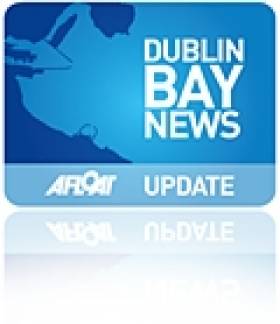Displaying items by tag: RNLI Dun Laoghaire
#SGTpepperCalls – Sgt. Pepper was among several workboats that called to Dun Laoghaire Harbour last week to begin short to long term projects. Notably one project involves dismantling and removing the former Stena HSS berth, writes Jehan Ashmore.
Multicat, Sgt. Pepper, a name synonymously associated with the ‘Beatles’ eight-studio album ‘Sgt. Pepper’s Lonely Hearts Club Band’ was released in the summer of 1967. Only two years previously the first custom built car-ferry was launched onto a summer-only service on the route to Holyhead.
Sgt. Pepper had arrived into Dun Laoghaire last Thursday. The workboat operated by McMullan Marine Services, had sailed from Arklow via Dalkey Sound (see: ‘Maritime’ Dalkey of the Dalkey Community Council newsletter, May 2015) To read more and of the 'Maritime' series dating to July, 2011 click HERE from the downloadable back issues.
On arrival at the harbour, Sgt. Pepper begin working inspection of the RNLI moorings opposite the lifeboat stationhouse and souvenir shop located between the Royal St. George and the National Yacht Clubs.
The lifeboat station has two craft. They are the RNLB Anna Livia at moorings and the inshore craft RNLB Realt Na Mara that is housed in the old lifeboat station located at the foot of the East Pier.
Two days later, Sgt. Pepper was joined by a barge, SB-5016 that was towed by tug MTS Valour from Stranraer, Scotland (also a former Stena HSS ferryport) down the Irish Sea to Dun Laoghaire. The 10-week long project at this harbour is to remove the HSS ferry berth and related structures at St. Michaels Pier terminal. The works are expected to be completed in August.
Not surprisingly the coverage of the decommissioned Boeing 767 that was towed by barge from the Shannon Estuary to the Sligo coastal town of Enniscrone, centred on the aircraft. Afloat.ie however researched as to the identity of the barge and the tug involved.
It transpires the tug, MTS Statum belongs to the same company, Marine & Towage Service that operates the MTS Valour used for the Stena HSS related project in Dun Laoghaire. As for the barge used during the western seaboard passage that was the Wilcarry 1500 operated by Williams Shipping.
Returning to the eastern seaboard harbour, is where plans to restore the seasonal-only Dun Laoghaire-Holyhead closed by Stena Line in 2014 cannot proceed until the HSS berth is removed.
Operators were sought by Dun Laoghaire Harbour Company through an E-tender process that in early 2015 which drew seven potential operators.
As the ferry berth removal project is underway and throughout this summer, this has delayed in restoring a seasonal –service that was originally envisaged to begin at the earliest this year. If a successful operator is secured such a service will not be available until 2017. For more on this story click here.
Also at the harbour berthed next to the Danish barge SB-5016 at St. Michaels Pier terminal was Dublin Bay Cruise excursion boat St. Bridget.
Offshore of the ferry terminal was the largest vessel within the harbour, ILV Granuaile. The lighthouse and aids to navigation tender that is based in the harbour is also where the Commissioners of Irish Lights HQ and adjoining marine depot is located beside the marina.
'Seafront Memorials' Tours of Dun Laoghaire Harbour
The tour which is free starts at the meeting point of the Queen Victoria Fountain which too forms part of the tour alongside the George VI memorial
and the Christ the King monument.
The outdoor event is part of the 'Summer of Heritage' which is organised by Dun Laoghaire-Rathdown County Council. The initiative is now in its fourth year and this year's highlight of the programme are tours of the newly renovated Seapoint Martello tower.
The coastal structure has been restored and is a fine example of these 19th century defensive forts, built along the coast to defend during the Napoleonic wars.
This summer also sees Carrickbrennan graveyard feature for the first time, the resting place of many sailors lost in maritime disasters since the 17th century.
Sightseeing along 'The Metals', a historic pathway that linked the quarry in Dalkey to the harbour in Dún Laoghaire also returns in the programme due to its popularity last year.
To read more about the the Summer of Heritage other free events in the arts, literature, sports, music and for the family, go to www.dunlaoghaire.ie/summer-of-heritage/ and www.dlrevents.ie/heritage11.html
- Events
- RNLI
- dlrcoco
- Dublin Bay News
- Dun Laoghaire Harbour
- Coastal Notes
- Dun Laoghaire News
- Seafront Memorials
- Guided Tours
- DunLaoghaireRathdown County Council
- DLR
- DLR events
- Martello Towers
- Seapoint Martello Tower
- The 'Metals'
- Queen Victoria Fountain
- King George VI monument
- Crimean War cannon
- Event news
- Napoleon
- Napoleonic Wars
- 1895 Dun Laoghaire Lifeboat Disaster
- RNLI Dun Laoghaire
- Christ the King monument
- Summer of Heritage





























































